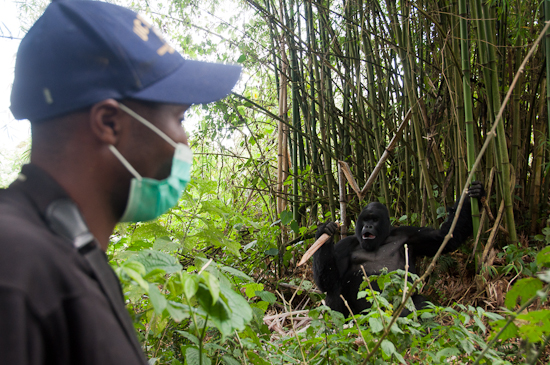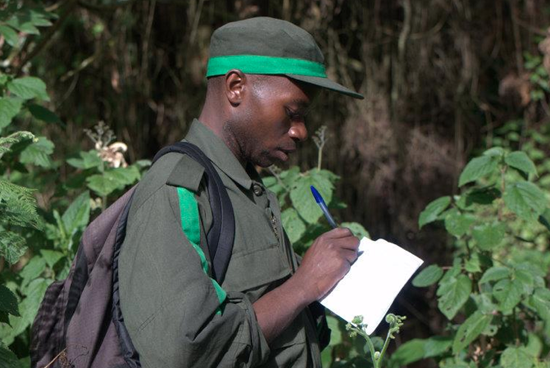Improved Health Monitoring Tool Benefits Veterinarians and Gorillas
By Gorilla Doctors Staff on Tuesday, January 17th, 2012 in Uncategorized. Dr. Eddy observes a silverback in Humba group during a health check.By Molly Feltner, MGVP Communications Officer
Dr. Eddy observes a silverback in Humba group during a health check.By Molly Feltner, MGVP Communications Officer
How do the Gorilla Doctors keep mountain gorillas healthy? The first step, and the foundation of our gorilla healthcare program, is gorilla health monitoring—visually observing the members of gorilla groups on a regular basis to check for signs of illness or injury. MGVP is only able to monitor and treat gorillas in habituated groups—groups that have grown accustomed to the presence of humans after a long process of being gradually approached by people. Luckily for the Gorilla Doctors, most of our patients are easy to find and comfortable being observed at close range. About 73% of mountain gorillas in the Virunga Massif are habituated while about 50% are habituated in Bwindi Impenetrable National Park.
The Gorilla Doctors visit every habituated mountain gorilla group once per month to perform a thorough visual health check. During a routine health check, the veterinarian tries to make visual contact with each member of the gorilla group in order to check a variety of health parameters:
- Body condition: Does the animal look well fed and healthy?
- Activity: Is the animal alert? Does it show any signs of weakness or lethargy?
- Respiration: Is the animal breathing well? Is it coughing or sneezing?
- Skin and Hair: Does the animal have any visible wounds, skin lesions, or unusual growths? Is its coat dull, discolored, or falling out?
- Head/Face Discharge: Does the animal have any visible signs of illness on its head or face such as a runny nose or eye discharge?
- Stool: Does the animal’s stool appear normal?
Careful notes are taken for each animal. When a gorilla is found to be suffering from human-induced or life-threatening injury or illness, the Gorilla Doctors, in collaboration with national park authorities, make plans to medically intervene in order to save the animal.
In addition to the veterinarians’ monthly checks, MGVP relies heavily on the observations of the trackers working for the national parks and organizations like Karisoke Research Center of the Dian Fossey Gorilla Fund International. The trackers see the gorillas every day and are trained by the Gorilla Doctors to look for any behavioral changes and other signs that could indicate illness and injury. Concerns are reported back to the Gorilla Doctors who follow up to perform own visual health checks.
To keep track of the health histories of the different gorillas the Gorilla Doctors record their health check data in a system called IMPACT (Internet Management Program to Assist Conservation Technologies). IMPACT was originally designed by programmer Rich Minus and was recently revamped by Medical Decision Logic.
 A Karisoke Research Center tracker records notes for the IMPACT system.Thanks to the improved system, we’re now training trackers to record their observations in IMPACT rather than simply reporting to MGVP when a problem is noted. By keeping an organized record of the daily observations of the trackers, the Gorilla Doctors and other researchers will have a much more in-depth understanding of the health trends in the population as well as a clearer picture of the overall health of individual gorillas. A group of 40 trackers from Volcanoes National Park and Karisoke Research were trained to use the IMPACT system this January. Trackers in Uganda and DR Congo will also receive training in the upcoming months.
A Karisoke Research Center tracker records notes for the IMPACT system.Thanks to the improved system, we’re now training trackers to record their observations in IMPACT rather than simply reporting to MGVP when a problem is noted. By keeping an organized record of the daily observations of the trackers, the Gorilla Doctors and other researchers will have a much more in-depth understanding of the health trends in the population as well as a clearer picture of the overall health of individual gorillas. A group of 40 trackers from Volcanoes National Park and Karisoke Research were trained to use the IMPACT system this January. Trackers in Uganda and DR Congo will also receive training in the upcoming months.
You can follow the Gorilla Doctors health monitoring efforts on our Facebook page, where we post photos and notes from our monthly visits.
Please consider supporting MGVP by making a secure online donation. Every dollar you give goes to directly supporting our gorilla health programs and One Health initiative. Thank you for your generosity.


 Donate
Donate